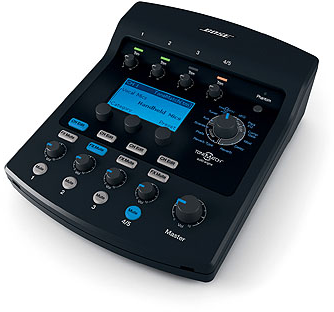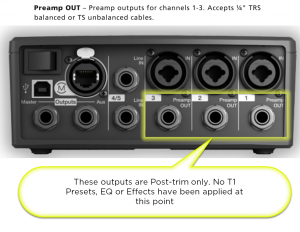Difference between revisions of "T1 ToneMatch® Audio Engine"
m (formatting) |
({{#lst:L1™ T1 ToneMatch™ Audio Engine/FAQ|Effects}}) |
||
| Line 1: | Line 1: | ||
<table><tr><td valign="top"> | <table><tr><td valign="top"> | ||
__TOC__</td> | __TOC__</td> | ||
| − | <td valign="top">[[Image:005 Bose T1.png | + | <td valign="top">[[Image:005 Bose T1.png|Bose T1™]] |
Announced March 29, 2007 | Announced March 29, 2007 | ||
| Line 19: | Line 19: | ||
== Effects == | == Effects == | ||
{{:T1 ToneMatch™ Audio Engine/Effects}} | {{:T1 ToneMatch™ Audio Engine/Effects}} | ||
| + | <!-- Labeled Section Transclude --> | ||
| + | |||
| + | {{#lst:L1™ T1 ToneMatch™ Audio Engine/FAQ|Effects}} | ||
== Preamps == | == Preamps == | ||
Revision as of 20:24, 2 June 2007
Contents |

Announced March 29, 2007 |
Related Documents
Effects
T1 ToneMatch™ Audio Engine/Effects
Preamps
Comparison to Model I and Classic
MikeZ-at-Bose tells us:[1]
... (the preamps on the Model I are)... exactly the same as the Classic.
On the T1 ToneMatch Audio Engine they're different, but are designed to the same standard as the L1 Classic preamps.
Functionally they are basically the same in terms of frequency response, input impedance, noise performance, max gains etc.
The difference comes in how we get there. I'll try not to go into horribly boring detail. The name of the game is trade offs, and in the end the design constraints dictate the *best* type of circuit used for *this* particular situation. Here are a couple of the many factors that dictate the differences:
Gain structure. The internal components of the T1 ToneMatch Audio Engine are different that the L1 Model I / L1 Classic and need to have signals fed to them in certain ways. Different designs are more suited to the levels needed than others.
Physical layout of the circuit on the board. There are four channels in a tighter space in the T1 ToneMatch Audio Engine. Again, certain designs lend themselves to be better at this than others.
After evaluating all of the factors that go into the design of a preamp we are using another proven circuit that relies more on discrete transistors rather than op-amps. It fits our needs better for this design situation. The preamp design itself is not necessarily any better or worse. There are *many* ways to skin the cat of preamp design to achieve a desired performance.
Will it sound different? No...I certainly cannot hear a difference playing through it. Can't measure one either.
Hope this sheds some light on it.
MikeZ[2]
Preamps Out
The preamp outputs are before everything except the Trim control in the signal chain. - MikeZ-at-Bose[3]. This means that these are post-trim, and nothing else (e.g. Muting) has any effect on the signal at the preamp outs.
Powerstand Input Setting
When using the Classic or Model I [4] The T1 has more input capability then the Model 1,s so you should be able to use the T1 as the only control for your system. We have a recommended trim setting for connecting the T1 to a Model 1 input Ch 3 or Ch 4 (I think it's 2). With this setting you will not distort or clip the Model 1 no matter what you do on the T1. You can even use the Model 1 without the remote.
The T1 controls are a heck of a lot faster then the R1 controls. There is no perceivable lag.
USB (Computer Interface)
T1 ToneMatch™ Audio Engine/USB
Cables
From T1 to Model II
Ken-at-Bose[5]
The T1 ToneMatch™ audio engine comes with a really nice Pro Ethercon cable, with robust metal connector shells and an almost memoryless 18' black cable.
However, in a pinch, should you forget the cable, or if say a huge Hammond B3 gets dropped on the cable and severs it, YOU CAN USE ANY ORDINARY CAT 5 ETHERNET CABLE and it will work fine until you replace you nice fancy T1 cable.
Later in that discussion Hilmar-at-Bose tells us:
Any CAT5 (or CAT5e, CAT6, or CAT7) cable will work just fine without any degradation at least initially. The downsides are that most ethernet cables don't coil particularly well and that the connectors wear out over time. After a a few hundred uses you may notice the occasional drop out, at which point it's time to get a new one.
It's certainly a quick and cheap way to get a spare for an emergency.
Cable Length
Up to 50 feet
A technical note from Bill-at-Bose [6]
A 33 or 50 footer will not cause any problems, either with the digital audio (ones and zips) or the power.
The technical reason follows, for those who are interested : A 24 gauge wire (the size typically used in ethernet cables) has about 2.5 Ohms of resistance per 100 feet. The T1 draws roughly 1/4 Amp on each of two supply wire pairs (+/-18V nominal).
For a 50 foot run, each pair of wires (made up of a plus and minus lead) totals 100 feet. A quarter Amp of current across 2.5 Ohms gives, per Ohm's law, a voltage drop of less than one volt (V=IR = 0.625 Volts). Because of the margin we built into the system, it can handle this voltage drop easily.
In fact, although we don't recommend it and can't guarantee it, the digital audio has been tested up to 100 feet in average conditions (for example, no undervoltage on the AC supply at the gig), and quite happily continued to make music.
Over 50 feet
MikeZ-at-Bose added in a later discussion:[7]
Bill at Bose stated you could run 50' of ethernet cable no problem at all. Success at distances longer than that would start to depend on outside factors, for instance the voltage of your power source.
Another option for you is to run the T1 ToneMatch Audio Engine off of the optional power supply, and then run a balanced line from the Master Out on the T1 ToneMatch Audio Engine to the balanced 'analog input' on the L1 Model II. This method would be able to transmit over a hundred feet, perhaps much more.
Display Panel
Outdoors
Q: Please talk about using the T1 ToneMatch Audio Engine outdoors. Will I be able to see /read the display? A: Should be no problem. The LCD display on the T1 is "transflexive". In dark conditions the blue backlight will shine through the "transmissible" part so everything is easily visible. In bright sunlight, it becomes "reflexive" just like a piece of paper. The backlight may wash out (i.e. it will not look really blue anymore) but it's still clearly visible. [8]
Design of Visual Components
Quoting Ken-at-Bose[9]
In 23 years at Bose, the L1™ model II and T1 ToneMatch™ audio engine are the most lovingly designed products I have ever had the fortune to work on. More care by more experienced people went into this than anything I've been involved in.
The most minute details were studiously created. As one tiny but important example, a propriety light pipe was designed so that the light from volume knob indicators smoothly wrapped around the knob from top to side, giving the musician a clear indication of volume from any angle. The color and intensity of the light was carefully designed so that it was visible in an extraordinarily wide range of stage lighting conditions.
- ↑ MikeZ-at-Bose talks about the preamps in the L1 Model I and the T1™
- ↑ MikeZ-at-Bose talks about the preamps in the L1 Model I and the T1™
- ↑ MikeZ-at-Bose -T1™ Preamp Out Muting
- ↑ Hilmar-at-Bose talks about setting inputs [1]
- ↑ Ken-at-Bose Steal this computer cable!!
- ↑ Bill-at-Bose talks about cable lengths
- ↑ MikeZ-at-Bose talks about T1 cable lengths
- ↑ Hilmar-at-Bose talks about the transflexive display on the T1™
- ↑ Ken-at-Bose speaks about development of the T1 ToneMatch™ audio engine



